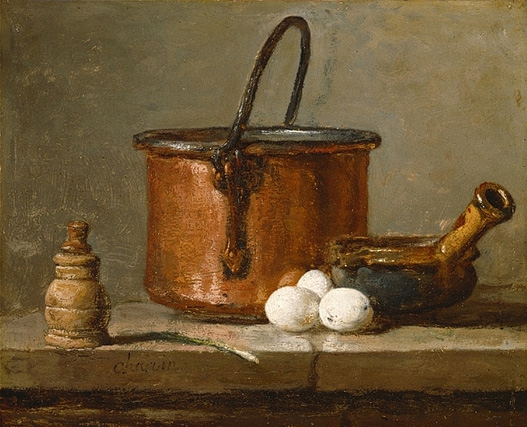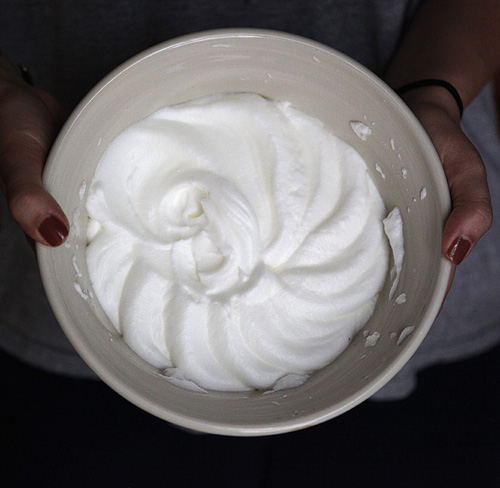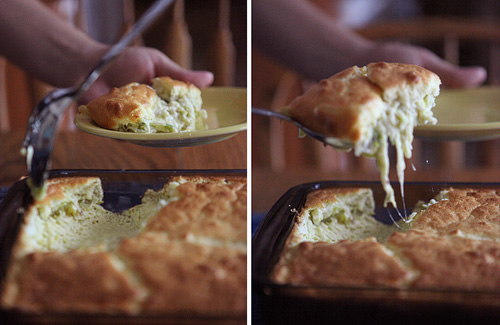The fluffy egg cake known as a soufflé can be made both sweet and savoury depending on the flavourings incorporated. In French, the word soufflé is the past participle of the verb souffler that translates to ‘to blow up’ – exactly what a soufflé does when it bakes. The method of creation is related to that of a meringue and the dish dates back to the 18th century. Often considered to be a fussy recipe, the soufflé is actually quite resilient and as long as whipped egg whites still retain some air they will not collapse. It is only when the soufflé cools that the dish will slump and so a quick oven to table service is essential. An old kitchen fable states a loud noise will cause a soufflé to fall but according to Howard Hillman in The New Kitchen Science,
“Though many a cook has blamed the collapse of a souffle on the spouse who slammed the kitchen door, the force of the shock waves from that deed is too weak to pop more than a few air bubbles, if any at all.”
– Howard Hillman, The New Kitchen Science (2003)

Jean-Siméon Chardin is an 18th-century French artist notable for his still lifes and interiors. He painted his subjects true to life in a quiet simplicity that was in direct contrast to the opulent extravagance of his Rococo contemporaries. Stylistically, Chardin mirrored his work on that of the 17th-century Dutch artists and enjoyed immediate success after his acceptance to the French Academy in 1728. In Still Life (c.1732), the objects on the table are softly lit with thick impasto paint which marked a stark contrast to the smooth translucent layers of paint and spot-lit ingredients by the Dutch artists Chardin regarded. As an artist, his ‘pure painting’ influenced the work of Paul Cézanne, Édouard Manet, Georges Braque and Henri Matisse, who copied many of his paintings at the Louvre.

Leek & Gruyère Soufflé
adapted from Williams-Sonoma Cooking from the Farmers’ Market
serves 6-8 people
1 stick of unsalted butter, divided
1 1/2 cups Gruyère cheese, grated
1/2 cup Parmesan cheese, grated
2 TB olive oil
4 leeks, cleaned and thinly sliced
salt & pepper
5 TB flour
2 1/2 cups heavy cream, warmed
6 eggs, separated
Preheat the oven to 390°F/200°C and position the rack into the top third. Generously coat the inside of a glass or ceramic baking dish (I used a 9 x 12 inch glass dish) with butter and evenly cover the bottom of the dish with 1/2 of the Gruyère cheese.
Warm the olive oil in a large frying pan over medium high heat and begin to cook the leeks. Sprinkle in the salt and pepper to season the leeks and sauté until tender, about 12 minutes. Remove from heat and place in a bowl to cool.
Return the pan to the stove top and turn the heat down to medium. Melt 5 TB of the butter and add the flour, whisking for 1 minute to form a roux. Slowly add the cream, whisking to keep lumps from forming. Keep whisking for 4 minutes, until the sauce becomes smooth and thick. Remove from heat and transfer to a large bowl. Slowly add the egg yolks, one at a time, stirring between each addition. Mix in the remaining cup of Gruyère cheese, 1/2 cup of Parmesan and leeks. Set aside.
In a large clean and dry bowl, beat the egg whites for about 5 minutes until stiff peaks form. Carefully using a rubber spatula, fold a quarter of the egg white mixture into the leek mixture. Once incorporated, quickly stir in the rest of the egg whites so that no white streaks remain. Pour into the prepared dish and slide into the oven. Bake for 25 minutes until the soufflé is golden brown. Serve immediately.


9 comments
Rosa says:
Aug 29, 2010
A marvelous soufflé! Gruyère is so delicious in such dishes.
Cheers,
Rosa
Joanne says:
Aug 30, 2010
I am so scared to make a souffle, especially for the blog because it will surely collapse before I can photograph it. I love the idea of a savory souffle though, and with leeks and gruyere, you can’t go wrong!
Hannah Stephenson says:
Aug 30, 2010
Drooling. Wow.
Tweets that mention Jean-Siméon Chardin – Leek & Gruyère Soufflé »Feasting on Art -- Topsy.com says:
Aug 30, 2010
[…] This post was mentioned on Twitter by Megan Fizell, Nezka Pfeifer. Nezka Pfeifer said: RT @tresjoliestudio: Leek & Gruyère Soufflé inspired by Jean-Siméon Chardin http://bit.ly/cNByUr #food #art #recipe […]
adele says:
Aug 31, 2010
Mmm. The souffle looks marvellous. The painting is lovely, too.
Julie says:
Aug 31, 2010
Fabulous post and fabulous souffle. Glad I got to eat some.
deana says:
Sep 2, 2010
Ooh la la, that souffle looks light as cook be and delicious at the same time… wonderful shots!
Autumnal Season Haute Louisiane | Fort de Chartres Heritage Garden says:
Jan 20, 2011
[…] lettuce, spinach and carrots making a simple dressing of the juice of a lemon, mustard and oil. A souffle of gruyere and leeks accompanied with a black Spanish radish remoulade and freshly baked bread prepared for the main […]
Marissa says:
Feb 18, 2012
This looks amazing! Want to try to make it this weekend if i have time. Great site! :)